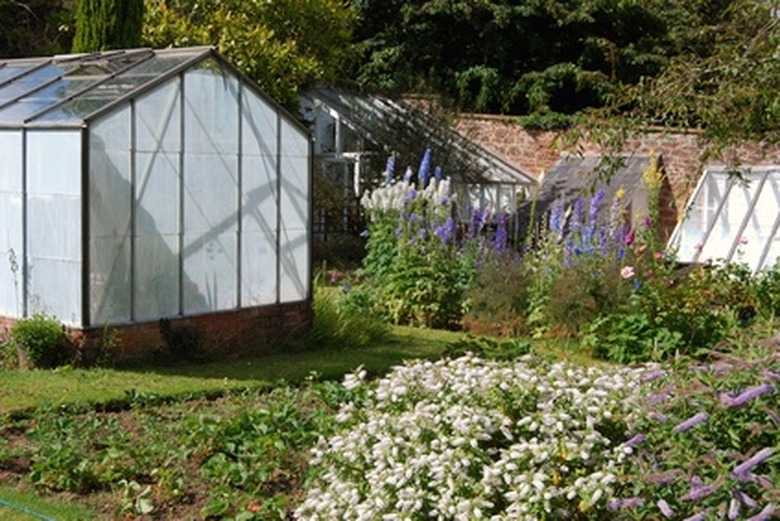How To Heat A Plastic Greenhouse Safely & Cheaply
Things Needed
- Polyethylene bubble wrap
- Black plastic rain barrel
- Water
- Compost bin
- Oil-burning space heater
- Plastic sheeting
- Soda bottle
- Wall 'O Water garden cloche
One of the most inexpensive hobby-type greenhouses is the hoop house. Hoop houses can be constructed quickly by staking PVC pipe to the ground in a half-circle shape to form a tunnel and then stretching plastic over the frame. During daylight hours sunlight naturally warms this type of greenhouse. At night, there are several simple and inexpensive methods you can use to heat the structure.
Step 1
Cover the surface of the hoop house with clear polyethylene bubble wrap. The clear surface of the bubble wrap will allow sunlight into the greenhouse for extra heat, while air pockets in the bubble wrap will insulate the greenhouse to help hold heat at night.
Step 2
Fill black plastic rain barrels with water and set them near your tender plants. The black plastic will attract more solar heat during the day to warm the water inside the barrels. At night, the water will release the heat as it cools to radiantly warm nearby plants. England's Centre for Alternative Technology calls this type of heating system a high thermal mass system.
- One of the most inexpensive hobby-type greenhouses is the hoop house.
- The black plastic will attract more solar heat during the day to warm the water inside the barrels.
Step 3
Place compost bins directly inside your greenhouse. During a hot compost process, a compost pile can warm to 120 to 160 degrees F., which will raise the ambient temperature of a greenhouse.
Step 4
Position a space heater on the floor of your greenhouse so it blankets your tender plants with heat during colder evening hours. Oil-burning heaters may be the most desirable space heater, as electric heaters burn more fossil fuels. Some space heaters come with a built-in thermometer that will automatically turn the heater on or shut it off when the ambient temperature fluctuates within a certain range. Despite this, monitor the temperature in your greenhouse with a separate thermometer and vent the structure if it becomes too warm.
Step 5
Insulate tender plants by covering them garden cloches made of plastic sheeting, glass jars or even plastic soda bottles cut in half and turned upside down. Cloches create secondary mini greenhouses that insulate tender plants by locking in heat. According to Utah State University, a cloche such as the "Wall 'O Water" may protect a plant to temperatures down to 16 degrees F.
- Place compost bins directly inside your greenhouse.
- Position a space heater on the floor of your greenhouse so it blankets your tender plants with heat during colder evening hours.
Warning
Heating with compost or oil-burning heaters can produce gas byproducts such as ammonia, ethylene or carbon monoxide that are harmful to certain plants and humans if they build up. If you use these heat sources, install carbon monoxide detectors in your greenhouse and vent the structure frequently.
